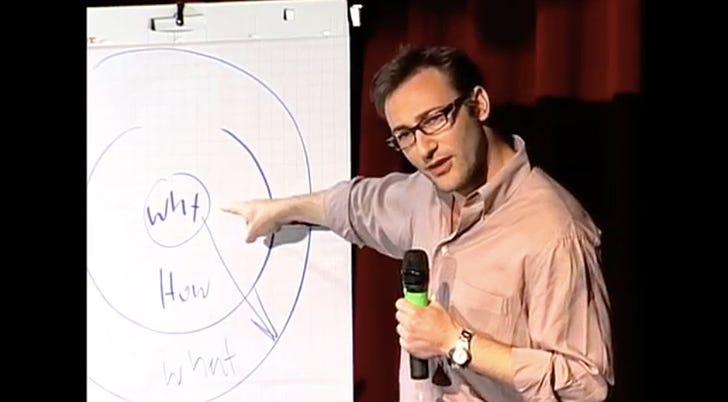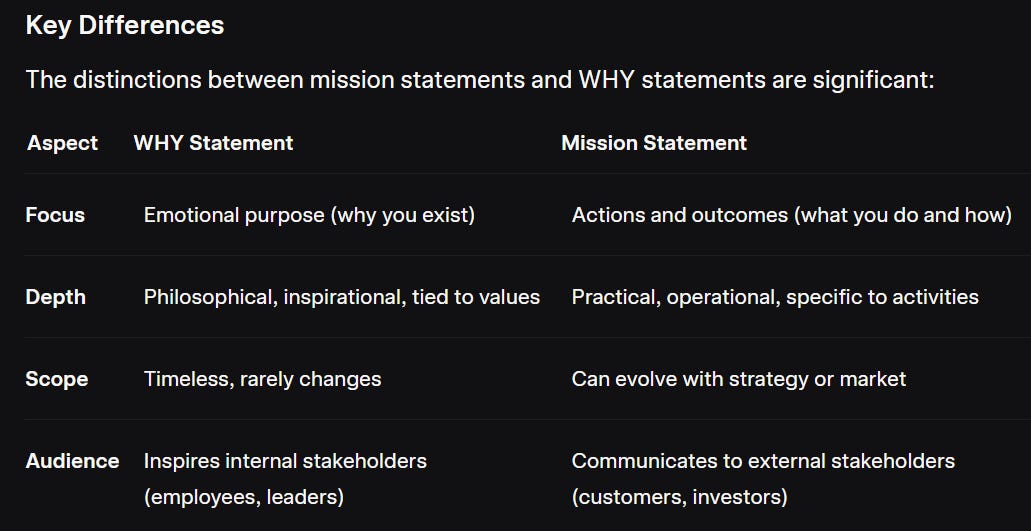The Shift from Mission Statements to WHY Statements and the Critical Role of Strengths Awareness
In today’s dynamic business environment, success hinges on more than just financial performance.
Consumers and employees increasingly seek organizations with a clear sense of purpose—a reason for being that resonates emotionally and aligns with their values.
Simon Sinek’s concept of the “WHY” has gained significant traction as businesses transition from traditional mission statements to purpose-driven models.
Leveraging the strengths of both business owners and employees is essential to realizing this purpose effectively.
Neglecting strengths, often due to psychological barriers, can lead to significant losses in money, time, and energy.
Understanding Mission Statements vs. WHY Statements
A mission statement typically outlines what a company does, how it does it, and for whom. For example, a software company might state, “To provide innovative software solutions to businesses worldwide.” This is clear, actionable, and focused on the “what” and “how.”
In contrast, Simon Sinek’s WHY statement, as introduced in his book Start with Why, captures the core purpose, cause, or belief that inspires a company’s existence, such as “to empower businesses to achieve their full potential through technology.”
The WHY is meant to inspire and guide all decisions, resonating on a deeper emotional level.
While some mission statements incorporate the WHY, such as Tesla’s “to accelerate the world’s transition to sustainable energy,” many focus on operational goals, lacking the emotional depth that drives loyalty and motivation.
The Shift to Purpose-Driven Businesses
The business landscape is evolving, with a growing emphasis on purpose-driven companies.
According to a Deloitte study, purpose-driven firms report 30% higher innovation and 40% higher employee retention.
Consumers, particularly younger generations, are driving this shift, with 66% willing to switch to purpose-driven products, per a Cone/Porter Novelli survey.
This reflects a broader demand for authenticity and meaning, pushing businesses to prioritize their WHY over purely operational mission statements.
Companies that fail to adapt risk losing market share to competitors who connect emotionally with their audience.
The Importance of Transparency
By clearly communicating their WHY, businesses attract customers and employees who share their beliefs, fostering loyalty and reducing friction.
Customers who don’t align with a company’s purpose will most likely demand constant changes to services not respecting company protocols and, wasting time and resources.
Patagonia’s WHY, “We’re in business to save our home planet” (Patagonia Mission), attracts environmentally conscious customers who support their mission without seeking substitutes.
Employees connected to a WHY are more engaged, with Bain and Company finding that inspired workers are 50% more productive.
Transparent communication of the WHY ensures alignment, saving businesses from the energy drain of mismatched relationships.
The Cost of Ignoring Strengths
When business owners fail to recognize and leverage their own strengths and those of their employees, the consequences are severe.
Research from Gallup shows that organizations investing in strengths-based development see up to a 29% increase in profit, a 7% increase in customer engagement, and a 15% increase in employee engagement (Gallup Strengths).
Disengaged employees cost companies up to 34% of their annual salary due to higher absenteeism and lower productivity.
For a $47,000 salary, that’s around $16,000 per year in losses, which is significant (Forbes Disengagement).
A Harvard Business Review study emphasizes that focusing on strengths is more effective than improving weaknesses, leading to better overall performance.
Ignoring strengths risks higher turnover, lower productivity, and a weaker bottom line.
The Psychology of Neglecting Strengths
Business owners who overlook their own and their employees’ strengths often fall prey to psychological barriers that hinder effective leadership.
According to Psychology Today, overconfidence can lead leaders to assume they already understand their capabilities, preventing them from seeking objective assessments like Gallup’s CliftonStrengths.
This cognitive bias, known as the Dunning-Kruger effect, causes individuals to overestimate their competence in areas where they lack expertise, leading to poor decision-making (LinkedIn Dunning-Kruger).
Fear of vulnerability may deter owners from exploring their strengths, as it requires acknowledging areas of weakness, which can feel threatening to one’s ego (Psychology Today Vulnerability).
These psychological barriers have tangible consequences.
A LinkedIn article highlights that leaders who ignore strengths-based approaches often micromanage or assign tasks poorly, leading to employee frustration and disengagement.
This misalignment wastes time and energy, as employees are not positioned to excel in roles that suit their natural talents.
A Harvard Business Review study notes that self-awareness, including understanding one’s strengths, is critical for leadership effectiveness, yet only 10-15% of leaders exhibit high levels of it.
By overcoming these psychological hurdles and embracing strengths-based leadership, business owners can foster a more engaged workforce, reduce financial losses, and enhance overall performance.
Why Strengths Awareness Is Wise
Investing in strengths awareness is a strategic move for business owners. Tools like Gallup’s CliftonStrengths assessment help identify individual talents, enabling owners to delegate effectively and assign tasks that align with employees’ strengths (Gallup CliftonStrengths).
This approach not only boosts productivity, it also enhances job satisfaction, as employees feel valued for their unique contributions.
A Psychology Today article underscores that leveraging strengths increases confidence and resilience, reducing burnout and turnover.
For business owners, being more conscious of heir own strengths allows them to focus on high-impact activities, such as strategic planning, while delegating tasks outside their expertise.
This clarity saves time, energy, and resources, positioning the business for sustainable growth.
Conclusion
While mission statements provide operational clarity, a WHY statement inspires and connects on a deeper level, aligning businesses with customers and employees who share their values.
Equally critical is the need for business owners to understand their own and their employees’ strengths.
Neglecting this due to psychological barriers like overconfidence or fear of vulnerability leads to disengaged employees, costing companies significant losses—up to 34% of an employee’s salary annually.
By embracing strengths-based leadership and transparently communicating their WHY, businesses can attract the right people, foster engagement, and achieve lasting success in an increasingly purpose-driven world.
Works Cited
Bain & Company. “Employee Engagement and Retention.” Bain & Company, www.bain.com/insights/employee-engagement-and-retention/.
Cone/Porter Novelli. “2018 Cone/Porter Novelli Purpose Study.” Cone Communications, 15 May 2018, www.conecomm.com/research-blog/2018/5/15/2018-cone-porter-novelli-purpose-study.
Deloitte. “Purpose-Driven Growth.” Deloitte Insights, www2.deloitte.com/us/en/insights/topics/strategy/purpose-driven-growth.html.
Eurich, Tasha. “Why Self-Awareness Isn’t Doing More for Your Career Than You Think.” Harvard Business Review, 13 Mar. 2018, hbr.org/2018/03/why-self-awareness-isnt-doing-more-for-your-career-than-you-think.
Gallup. “CliftonStrengths: How It Works.” Gallup, www.gallup.com/cliftonstrengths/en/252137/how-cliftonstrengths-works.aspx.
Gallup. “Strengths Meta-Analysis 2015.” Gallup, www.gallup.com/cliftonstrengths/en/269615/strengths-meta-analysis-2015.aspx.
Hedges, Kristi. “Developing Employees’ Strengths Boosts Sales, Profit, and Engagement.” Harvard Business Review, 1 Sept. 2016, hbr.org/2016/09/developing-employees-strengths-boosts-sales-profit-and-engagement.
Johnson, Sarah. “The Dunning-Kruger Effect: Why Some Leaders Overestimate Their Skills.” LinkedIn, www.linkedin.com/pulse/dunning-kruger-effect-why-some-leaders-overestimate-their-skills-johnson/.
Kaufman, Scott Barry. “The Benefits of Knowing and Using Your Strengths.” Psychology Today, 10 Oct. 2020, www.psychologytoday.com/us/blog/click-here-happiness/202010/the-benefits-knowing-and-using-your-strengths.
Keller, Gary. “Why Knowing Your Strengths Is Key to Success.” Psychology Today, 29 Sept. 2022, www.psychologytoday.com/us/blog/the-science-of-success/202209/why-knowing-your-strengths-is-key-to-success.
Koval, Robin. “Why Vulnerability Is Key to Leadership.” Psychology Today, 25 May 2021, www.psychologytoday.com/us/blog/finding-new-home/202105/why-vulnerability-is-key-to-leadership.
Patagonia. “Our Mission.” Patagonia, www.patagonia.com/our-mission/.
Smith, Emily. “Why Strengths-Based Leadership Is Key to Unlocking Team Potential.” LinkedIn, www.linkedin.com/pulse/why-strengths-based-leadership-key-unlocking-team-potential-smith/.
Spector, Nicole. “How Much Are Your Disengaged Employees Costing You?” Forbes, 2 May 2019, www.forbes.com/sites/karlynborysenko/2019/05/02/how-much-are-your-disengaged-employees-costing-you/.
Donate
If this post was supportive and you want to donate, you can to so through the links below:
CashApp Donate ($uniqueselfmoney)
PayPal Donate (@valuenathan)
Venmo (@UniqueSelfVale)





